Antiquities: Minidisk in the Age of Ipod
When Philips closed the digital compact cassette project in 1996, it did the right thing. The point is not that the digital cassette has lost to the digital minidisk. Rather, both formats turned out to be insufficiently in demand: on the one hand, they were hampered by cheap and familiar audio cassette, on the other - by the Internet and music, devoid of media. Last week, I talked about the minidisc in their natural habitat - when the Internet and MP3 did not seriously compete with the format. The minidisk was too expensive to become massive, but gained recognition among professionals, enthusiasts, and simply non-poor people.
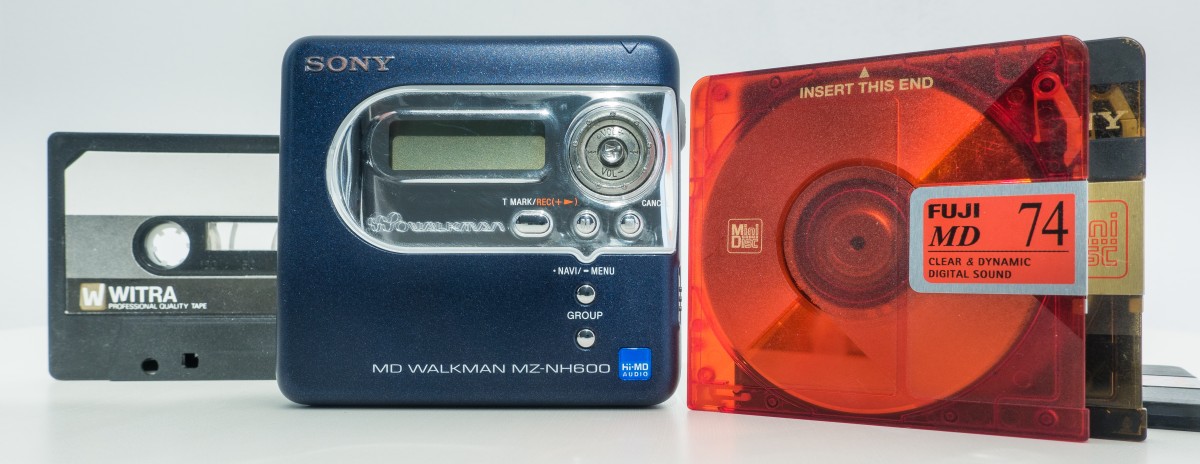
Today I will talk about the minidisc in the era of MP3-players. Physical media with all its limitations, by definition, was not able to compete with portable devices based on hard disk or flash memory. Moreover, already at the beginning of the two thousand, the “music player” became part of other digital devices, and as soon as they became more or less convenient, not a single physical carrier had a chance. However, thanks to Sony’s perseverance, the history of the MD does continue until 2006 — when the latest new device was introduced. Sony three times tried to update the format for new consumer requests, and lost three times, and probably the idea was initially doomed to failure. But now, five years after the final cessation of support for the format, I have the opportunity to try out a few old devices, and tell them about them.
I keep the diary of the collector of old pieces of iron in real time in the Telegram . About some features of mini-disk devices there are written in much more detail.
')
First I want to resolve the misunderstanding that arose in the comments to the previous article. Minidisk and Mini CD are different formats. The Mini CD is a smaller copy of a regular 8 cm diameter CD (24 minutes of audio or 210 megabytes of data). Despite attempts to make it a portable format, devices using compact CDs (or DVDs, such were also) can be counted on fingers. The minidisk has a smaller diameter (64 mm), is equipped with a metal insert in the center and is closed in a protective case that is similar in construction to a floppy disk.
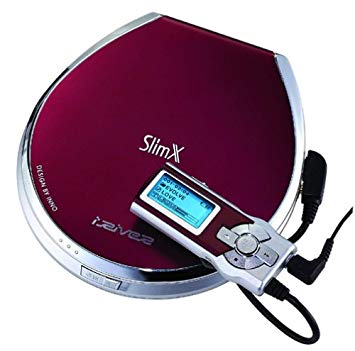
In the previous article I stopped at the end of the nineties, when the first MP3 players appeared. These were not the most convenient devices, but their advantages were obvious: there is no need to buy music carriers at all, rewrite a new collection of 64 or 128 megabytes of a portable device at least twice a day, without restrictions. A bit later, players with a built-in hard disk were added to them, and portable CD players experienced a brief renaissance thanks to the ability to play compressed music. The devices were rather clumsy, the first MP3 players used a parallel port for data transfer, and at the beginning of the two thousandths this was certainly the future, but it was not cheap and with dubious qualities.

But portable mini-disc recorders have reached perfection. In the 2000th year, the Sony MZ-R900 model is released, and after almost 19 years I buy such a player, and I am incredibly lucky: the device in a fashionable color blue metallic comes new (!), In a box with all the accessories. The player's dimensions have decreased even compared to the thin MZ-R55, and the battery life has increased - up to 26 hours of work from the built-in flat battery, and up to 66 hours with an additional case for one AA battery. Anti-shock increased to 40 seconds, and the larger the buffer, the less often you have to turn the disk, the lower the power consumption. The MZ-R900 is the best implementation of the format in its original form.

The main feature of the model is the support of the new standard MDLP. Here begins the confusion of terms, trademarks and names, which will pursue the minidisk to the very end. MDLP makes it possible to record on a minidisk in two or four times more information than was previously available. Prior to that, a minidisk contained a maximum of 80 minutes of music, or 160 minutes in mono mode. On the Sony MZ-R900, you can record 160 minutes of stereo sound or 320 minutes with reduced quality. The ATRAC3 codec is used for this, but wait, the last time I said that in the decks of the late nineties, was the ATRAC4.5 format already? Yes, but this is not the ATRAC . The first one, with all its modifications, was renamed ATRAC SP, and ATRAC3 is a completely new format. Where did ATRAC2 go then? Unknown. Third-party manufacturers had their own numbering of the original ATRAC codec, for example, Sharp had versions 5 and 6.
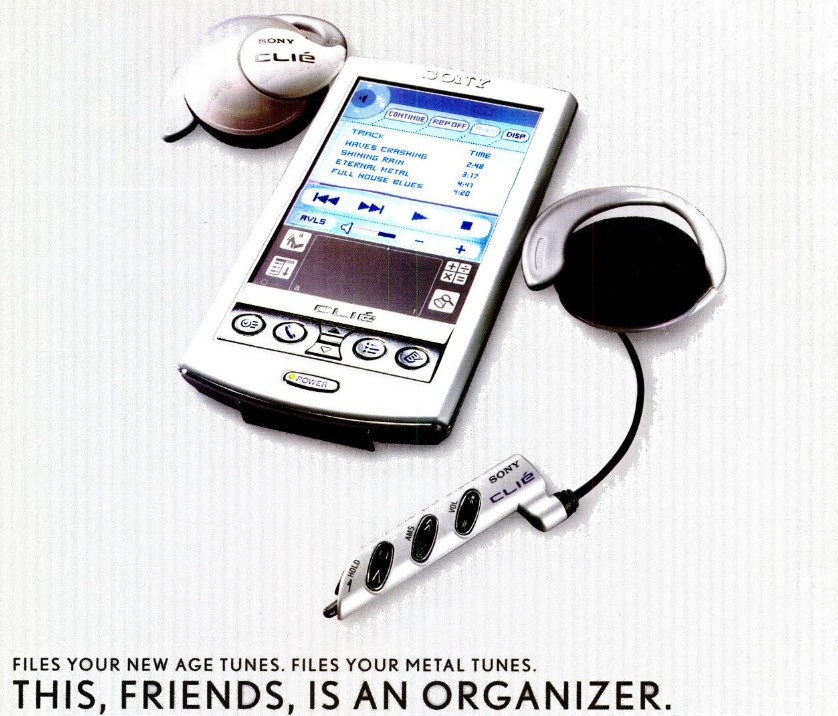
In 2001, even Sony itself advertised completely different products.
In short, the new LP2 and LP4 recording modes first appeared in the new Sony player. The first has a 132 kilobit bitrate per second, the second is 66 kilobits. LP4 is of little use for music, but it allows you to record more than five hours of voice notes per minidisk, with acceptable quality. LP2 according to characteristics approximately corresponds to MP3 with a bit rate of 128 kilobits per second. Sony is even conducting a study in which LP2 shows a slight advantage over MP3, although ATRAC3 ranks last in this independent test.
Regardless of the quality, the ability to record 2 hours and 20 minutes of music on a standard minidisk is useful; most of the double albums and compilations will fit in such timing. At the end of December, I go on a New Year's trip, and take a 2-hour Depeche Mode concert with me on the mini-disc. MDLP was the latest version of the MD, which produced the entire range of audio devices: home, portable and car. The Sony MZ-R900 looks gorgeous even at the modern look, it is very convenient to use it thanks to the wired console, large screen and two jog dial joysticks on the case, it sounds great and shows a good result in objective measurements. Whether to change the playback time to sound quality - the choice is yours.
80 minutes or 160 - you still have to rewrite them on the MD in real time. Meanwhile, in 2001, Apple released the very first iPod MP3 player, still with a mechanical scroll wheel, with a monochrome screen and a 5 GB hard drive. By modern standards, a little, but then the player advertises the ability to carry with them all the music in general. 5 GB with a bit rate of 128 kilobits per second is about 86 hours of sound or 32 minidisks. Doofig. First, sales of iPod are small, the device works only with Apple computers, and only through the Firewire port, but over time these shortcomings will eliminate, and on the whole, Apple’s current success largely resulted from good sales of iPods in the two thousandths.
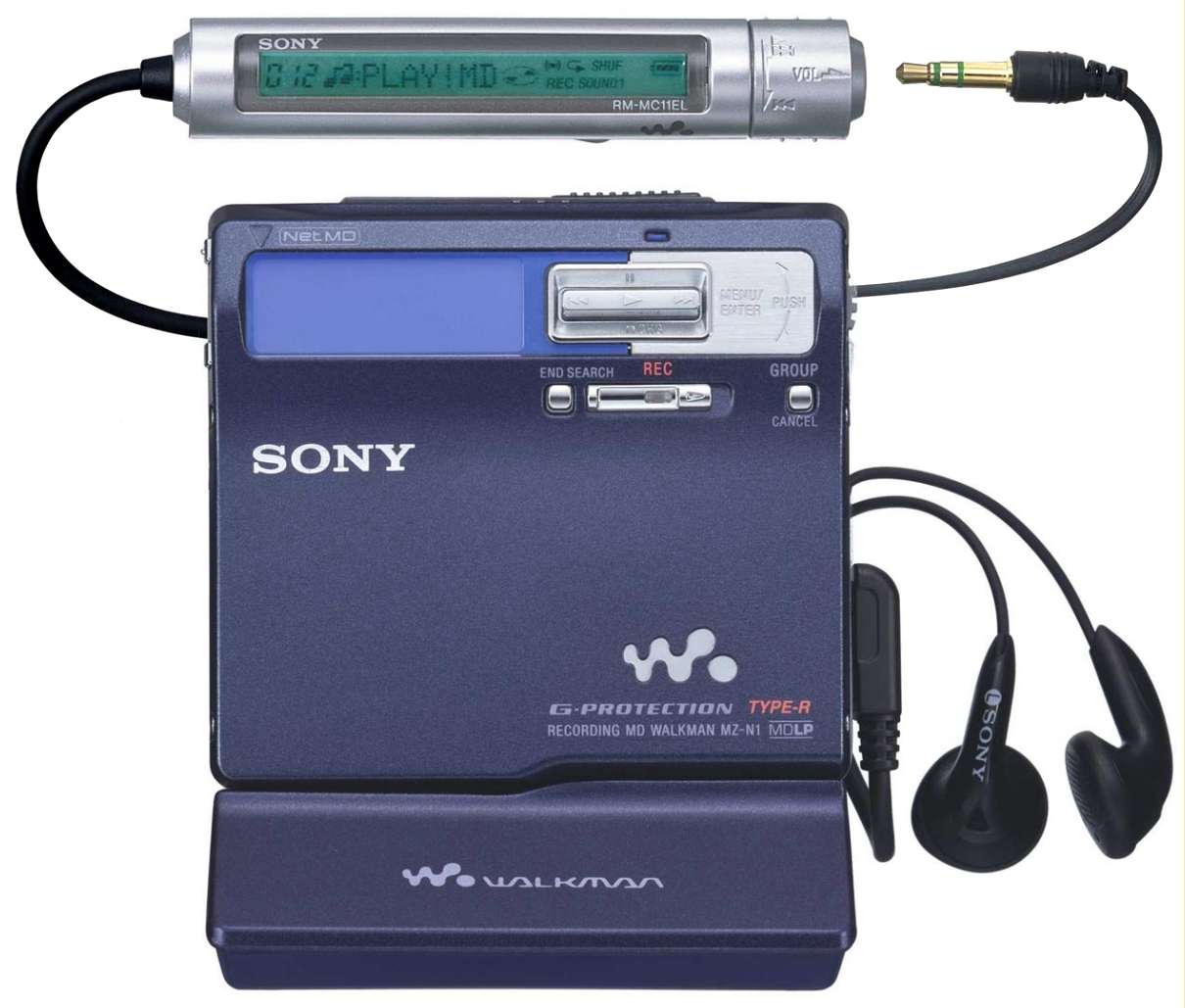
And Sony at the end of 2001 represents the NetMD format - this is essentially a mini-disk recorder with a USB port. In theory, this is an interesting proposal. You can transfer music from a computer to MDs 16 times faster than real time (for LP2 format). Recorders are expensive, well, and the iPod is not cheap, but you can decide for yourself how many MDs you need. The first NetMD recorder - Sony MZ-N1 - a very beautiful model with a docking station, up to 110 hours of battery life. I’m buying another device in the collection - the Sharp IM-DR410H recorder . This is a relatively inexpensive (210 euro at the start of sales) model of 2003. It works from one finger-type battery, it does not have a remote control, but it has convenient buttons and a digital sound amplifier, which promises an incredible high.

And this exhibit of my collection, everything goes wrong. The device looks almost perfect, but as it turned out after the first start, only one MD can lose, which was attached by the seller. The reason for this was, apparently, a fall to the floor, because of which the appearance did not suffer, but a fastener connecting the halves of the mechanism inside was riveted. I conjured a screwdriver, laid a piece of paper with a frame that presses the minidisk on top (it bent on impact), and brought the device into working condition.

Next, it was necessary to connect the player to the computer, and this was also a problem. On the Sharp site, the advertising page of the beginning of the two thousandth is still available, but nowhere can I download the bundled software and drivers, and I did not have a disk. Sharp devices used the BeatJam program, and Sony used a different software for its recorders — SonicStage, which Sharp doesn’t see. I never found BeatJam - the minidisc community forum would help, but just a month before my experiments started, it was turned off. ( Amendment: at the time of this writing, it was turned back on, hurray! ).

I had to use moderate mad skillz - I registered the Sharp's USB ID in the driver for Sony's mini-disk recorders, and after that it worked. Sony SonicStage (the latest version that supports MiniDiscs -3.4 4.3) works even under Windows 10, but there are no drivers for 64-bit systems. There is a possibility of finishing, but I recreated the NetMD computer infrastructure on an old ThinkPad T43 laptop with Windows XP.
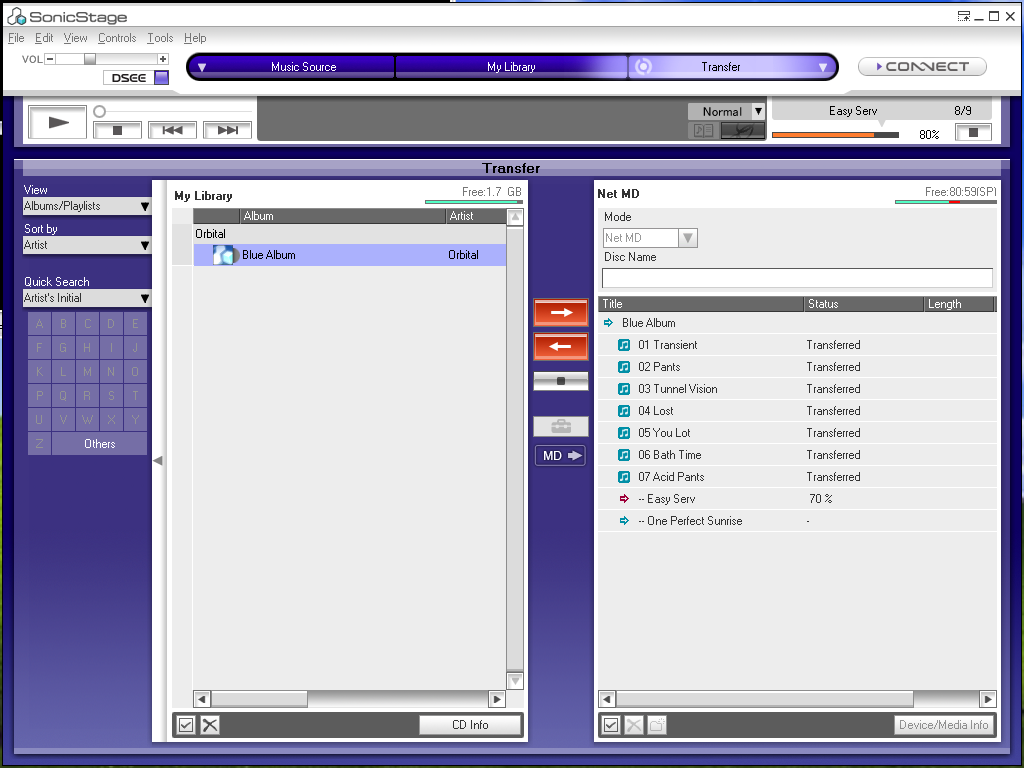
SonicStage interface is similar to that of Apple iTunes. By today's standards, the program is quite limited, and does not understand many music formats. I used it mostly with MP3 and WAV files. There is a possibility of organizing a library of files, writing tags, creating playlists. You can live, questions begin when copying music to the minidisk. First, you can only record music on the minidisk, you can not back. Secondly, in earlier versions of the software there was a limitation - one track could be recorded on the mini disc no more than three times, after that it was necessary to carry out the so-called check-in - in fact, remove the track from one of the disks by connecting it to the computer.

But this is not the biggest problem. I added an album to the SonicStage collection, and he signed up for a minidisk at about tenfold speed - not bad. But this is the LP2 format with a bit rate of 132 kilobits per second. If your collection of music is in MP3 (and there were hardly any other options at the beginning of the two thousandth), then there is a double lossy conversion of music — first to MP3, then to ATRAC3 LP2. Is it possible to use the original ATRAC SP codec with a bit rate of 292 kilobits per second? It is possible, but here I was waiting for the two largest pitfalls. First, recording in ATRAC SP mode is very slow, at a speed of about 1.6x from the real one. As far as I know, this is because coding to the original ATRAC is possible only on the device . A software encoder does not exist until now , there is only a later developed and included in the ffmpeg package decoder (the fruit of reverse engineering fans).
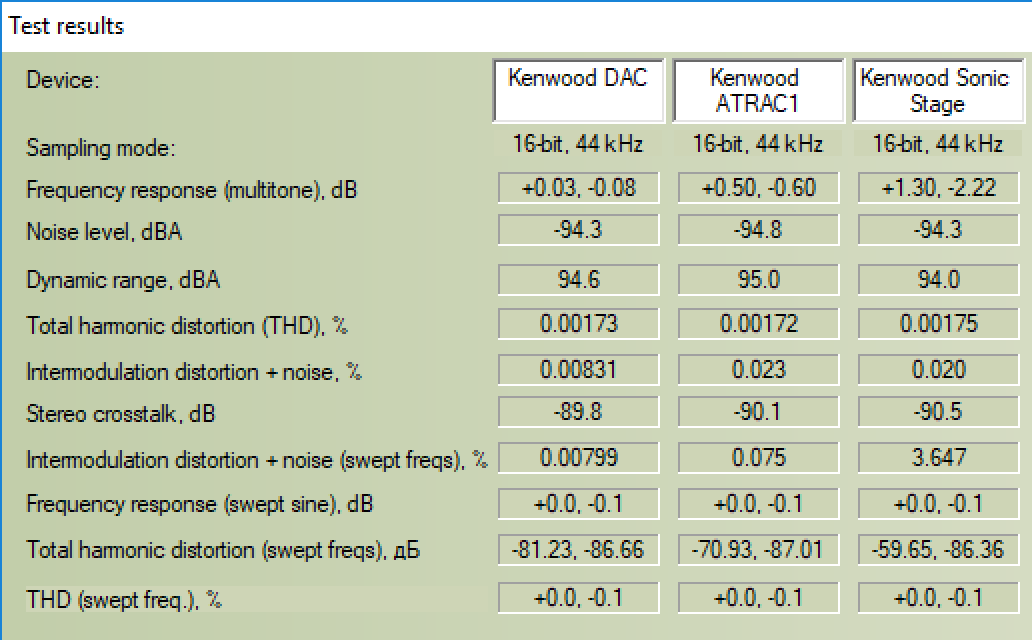
Regardless of the quality of the source, before you transfer data to the MD, it is forced to encode to ATRAC3 LP2 format. Seriously, I even checked it myself, comparing the measurements of the MD recorded on the deck, in the old-fashioned way, and the minidisk recorded on the computer. The second option shows a noticeable increase in distortion - a clear sign of additional losses during compression.
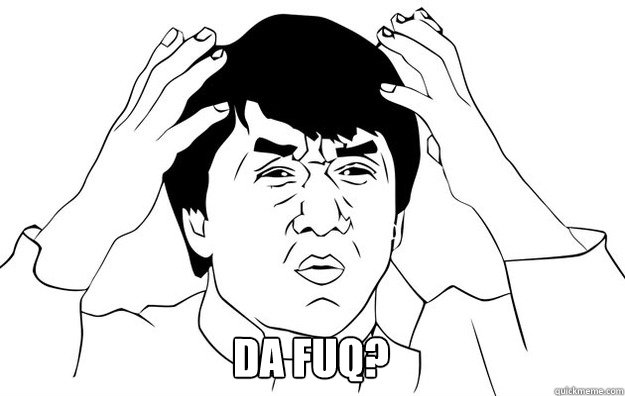
Rate the degree of idiocy. Suppose you have music in good quality, for example, in MP3 320 kb / c. You want to record it on the minidisk in ATRAC SP format so that your old mini-disk deck (like mine) can play it too. SonicStage converts your MP3 to ATRAC3 LP2 (second lossy compression), then decompresses the sound to PCM, transfers it to the player, where it is converted to ATRAC SP (third compression!) By the device. How so? Why was this giant crutch inserted? Copyright? So it was easier to code? Imagine yourself in the place of a longtime minidisc fan, with an archive of records and old devices that expects NetMD to complement its infrastructure. But it does not complement. You either have to switch to an ATRAC3 LP2 that is incompatible with technology before 2000, or (perhaps you will not hear, but) you will know that you are writing compatible discs from a computer with completely unnecessary loss of quality.

Judging by the reviews of contemporaries, the impression they had was exactly this: Sony rotates fans of the format on the copyright spit. In order not to get up two times, add: the discs recorded on the computer cannot be edited on the player or recorder. No way, just format. They are marked as protected. For some reason, this mark is not put in the additional utility MD Simple Burner - this is a program for copying music to a minidisk directly from a CD. I use it with an optical drive emulator, and in general it works well. Even if you score on all these subtleties, the preferred way to work with a portable device at the beginning of the two thousandth is to write a dummy or transfer files to a portable player in the form in which they are stored on the hard disk. And that's not all.
To the frustration of NetMD added ambiguous impressions of the Sharp device. This Japanese company tried to differentiate their Minidisk players from Sony devices in design, features and sound. At the beginning of the two thousandth, she applied the technology of "digital one-bit sound" - in fact, she implemented a digital headphone amplifier in portable technology, which in theory is no different from that in modern smartphones. But this is in theory, but in practice Sharp decided to introduce a balanced power amplifier. The Sharp player has a four-pin connector, each channel is connected separately, while in ordinary headphones the left and right channels have a common ground. Included is an adapter from this connector to a conventional three-prong, but it is intended only for connecting a device in the line input - for example, to a car stereo. Headphones through the adapter sound awful because of the high output resistance.

What kind of headphones with a player put - so with them and go. There are simple “droplets” there, not bad, but modern headphones are much better, and I even solder my Sennheiser ie8 to work in balanced mode. It was difficult to measure the characteristics of the player in the RMAA program: all parameters were as expected, except for channel separation. The test showed that the separation was almost absent, as if the player was working in mono mode. Another measurement of a similar model ( here ) showed similar results. After a couple of experiments, I realized that the parameters of this player can be measured correctly only under load - I had to solder the headphones to the connecting cable, and only then did I get the characteristics I expected.
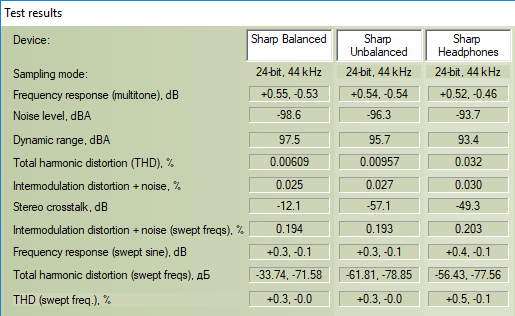
The promise of “Excellent Sound” was confirmed in the measurements: judging only by numbers, this is the best player in my collection. In fact, his sound is muddy, dull and generally markedly different from any other technique at my disposal. It is not ok. And in the recording mode, the modified ATRAC encoder adds some gag to the signal. Nevertheless, this Sharp is the ancestor of modern audiophile portable players with a balanced headphone amplifier.
The NetMD format was supported by fewer Japanese manufacturers. I don’t have any sales information, but I don’t think that Sony managed to catch up with the miniDisc iPod and manufacturers of rapidly decreasing MP3 players, a lot of handheld computers and smartphones with music features. The story should definitely be finished, but there was another attempt.

In January 2004, Sony announces (as the media says - returns from non-existence) a new format of minidisks - Hi-MD, with a capacity of 1 gigabyte, seven times the size of regular MD, while maintaining the dimensions. The principle of writing and reading data is still magneto-optical. The magnetic head is used for recording, and the disk is preheated by the laser to high temperatures. Only laser is used for reading. The recording density was increased with the help of several technologies at once. Magnetic writing to a high-density disk is possible in principle, but upon reaching a certain limit, it becomes impossible to read the data. This task was solved using the Domain Wall Displacement Detection method — another layer was added to Hi-MD discs aimed solely at improving the accuracy of reading. In addition, software methods were used: the EFM data coding method (also used in compact discs and providing the ability to recover data from damaged areas) was replaced with a more efficient RLL . PRML technology was introduced, also increasing the likelihood of successful data reading. She, like RLL, was borrowed from hard drives.
Furthermore, Hi-MD devices provide enhanced backward compatibility. Not only can they read data from traditional minidisks, but they can also reformat them with a doubling of capacity — about 80 megabytes of data can be written to an 80-minute standard MD. And here we are talking about data, and not just about sound: for the first time, the minidisk becomes a relatively convenient format for storing files. Any Hi-MD recorder can be connected to a computer via USB and without any software can be used as a USB flash drive.

Only very slowly, and by modern standards, and by the old - approximately at the level of a two-speed CD-ROM. These are indicators of conventional MD formatted according to the Hi-MD standard. Real gigabyte Hi-MD disks should work twice as fast, but I can’t check it - there are no disks. In general, I was going to study this part of the history of minidisks "based on materials on the Internet" - the prices of equipment and carriers are completely irresponsible. Sealed Hi-MD discs are sold for 30-50 dollars apiece, several times more expensive than their original value of seven dollars. The players are also not cheap, but I’m lucky and I’m cheaply buying the Sony MZ-NH600 in almost perfect condition.

This is a budget (200 dollars) model of 2004: it works from a finger battery for up to 27 hours in playback mode, and when connected to a computer it receives power via USB. The case is plastic, the buttons are not so convenient compared to the reference MZ-R900, for some reason many functions are hung on the microscopic wheel, and everything else is put on an even more miniature five-way joystick. In the USA, this model is not even equipped with a line input, recording only through a computer. In general, a very convenient and compact model, though not as cool as the flagships (about them later). The only problem - a very quiet headphone output - a consequence of EU legislation on limiting the maximum volume. But I solve this problem with the help of the service menu (more about this in my Telegram ).
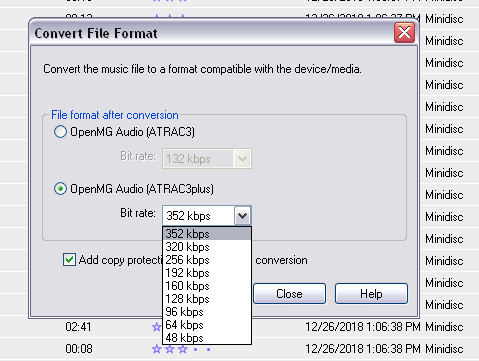
If you want to record music to Hi-MD, you still need to use the SonicStage program. Together with the new disc format, a new standard (another one) for lossy data compression, ATRAC3Plus, was developed. It offers a wide range of bit rates, as well as MP3, the maximum - 256 kilobits per second (later it will be expanded to 352 kilobits). There is an opportunity to record uncompressed audio on a minidisk with a full CD quality - one and a half hours on a Hi-MD disc and 28 minutes on a standard but reformatted minidisk. In 2004, it was this opportunity that interested me, but instead of a minidisk, I buy my first 40 GB iPod.

Table of formats supported on Hi-MD devices from minidisc.org
What is the result? With a bit rate of 256 kilobits per second, you can record almost 8 hours of audio per gigabyte Hi-MD disc. If you use the more economical ATRAC3 LP2 codec, you’ll generally get 16.5 hours. A couple of discs can carry a lot of music with them, and even on old mini discs you can record almost five hours of audio in decent quality. True, you can read all this only on Hi-MD devices - all previous devices will not see the new format. Finally, you can copy music not only to the minidisk, but also back! The truth is with limitations: only from Hi-MD discs, those who want to extract music from their old minidisks are again in the span. Sony is gradually releasing the copyright reins, and eventually it becomes possible to extract music from the original MD, but only if they are recorded via an analog input. But there is a big life hack, more precisely a hardware cheat code.

In 2006, Sony released the latest (now for sure) Sony MZ-RH1 minidisk player. Usually, at sunset format only the cheapest and most dull in design and device characteristics remain on sale. But RH1 is not like that; it’s the real top, the top of the format capabilities. The thickness of the player is 15 millimeters, almost three times less than that of the very first minidisc device MZ-1. Weight 106 grams with battery, 6.5 times less. Incredibly cool OLED-display, lithium-ion battery with the ability to charge via USB.
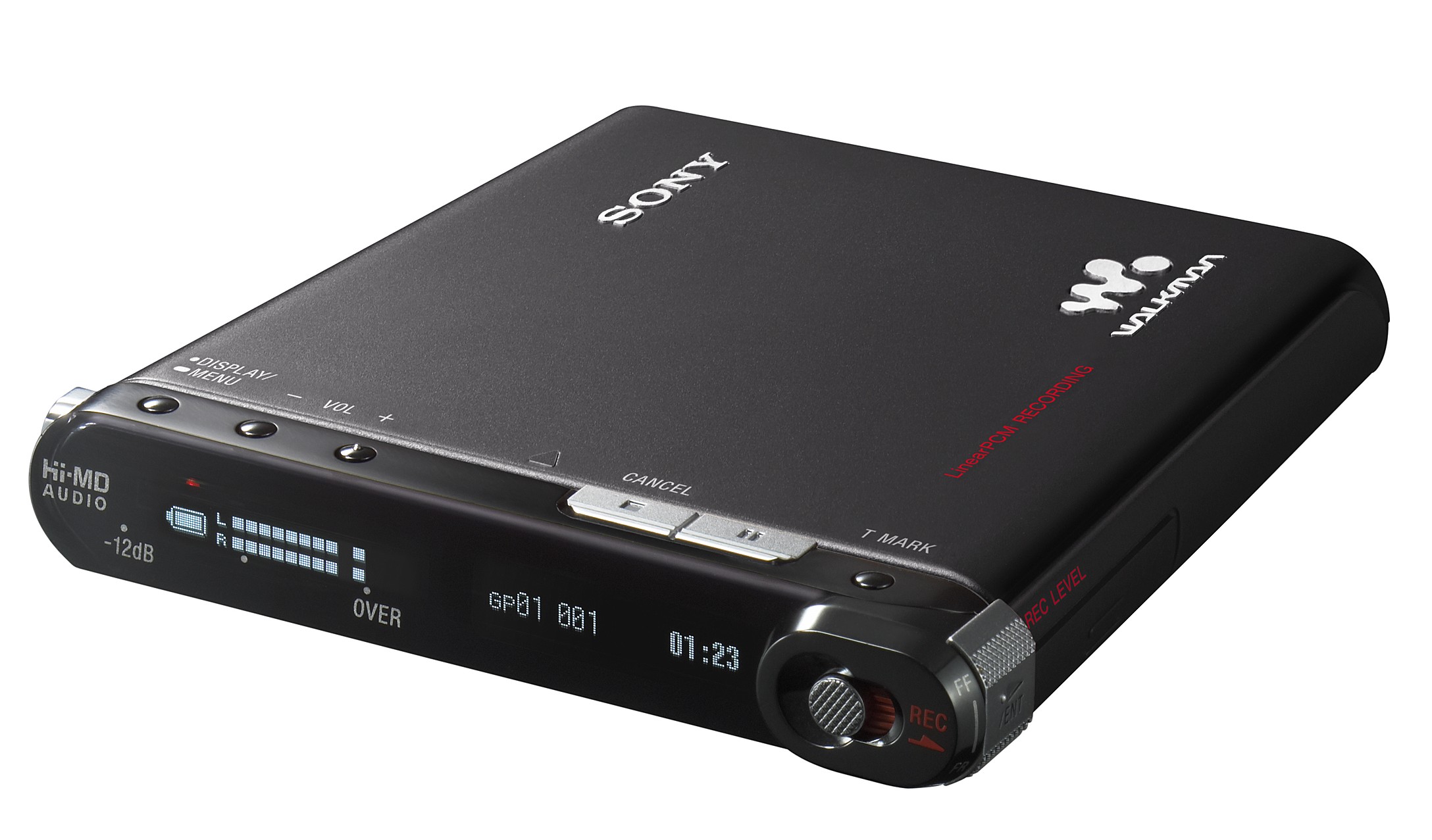
I don’t have such a player, the prices for it are completely equine - much higher than it cost the new one in 2006. In addition to technical excellence and collection value, there is another reason for such a high price. This is the only MD player capable of transferring data from standard MD without restrictions . If you have a large collection of your own music or other audio recordings on minidisks, and you used a digital interface for recording, then you can get these records relatively painlessly only with the help of RH1. Or it is necessary to use more complex methods: I successfully extracted digital sound from the MD, replacing the table of contents using the TOC Cloning method described in the previous article. The MZ-RH1 has no practical meaning: as with any top-end player, it has its drawbacks, for example, a proprietary and incompatible battery and a burnable OLED display. My MZ-NH600 is more practical.
In the middle of the two thousandth, work begins on the reverse engineering of the NetMD and Hi-MD protocols. Information about the linux-minidisc project can be obtained here , and here are the sources . The mailing list of the project participants makes it clear how difficult it was for them to analyze the most closed minidisc architecture. But after all, for the iPod, which was also closed on all sides, third-party file managers came up with it, and even wrote a whole alternative firmware. Perhaps, if the devices were a bit more popular, it would have happened with Sony NetMD and Hi-MD. In fact, the project is not dead, but the development has stopped halfway.

Since Hi-MD uses the usual FAT file system, it is best supported in Linux, there is even a simple graphical interface for transferring files back and forth. But the support of traditional minidisks (no matter what device) leaves much to be desired. In fact, you are dealing with a set of utilities (or Python scripts, at your choice) for copying music to a minidisk (for all NetMD devices) and back (if you have MZ-RH1). It was not possible to break the NetMD protection to the end, and perhaps this requires the extraction and modification of the firmware of the devices. It is unlikely that someone will do it now - what's the point of disassembling outdated hardware? Console utilities are the only way to download music to the minidisk in the original ATRAC SP format without unnecessary transcoding to LP2. Alas, the utilities are unstable - the device constantly freezes, you have to reconnect it and start again.
After the release of the MZ-RH1 player in 2006, there was nothing to hear about the MDs, until in 2013 Sony announced it would stop supporting the format. Was minidisk a failed product? It seems to be yes: all my life sales were relatively small, devices and carriers were expensive, and recent attempts to adapt the format to the requirements of the network century failed. And why did this happen? Someone will say - the format was too closed. And it will be right, see above examples about stupid limitations when working with a mini-disk on a computer. But the iPod was also like that. There, too, it is impossible to get music from the player back to the computer using standard means. The same codec set is also used (but MP3 is supported). In 2004, along with Hi-MD, Sony opened its online music store, a year after the iTunes Store. Both there and there the tracks are smeared with a thick layer of copy protection: only in 2009 the Apple store will completely abandon DRM.
Okay, then probably this format appeared too late: if we released it along with a compact disc in 1982, we would now recall with nostalgia MDs, not tapes. It would be nice, but the principle of magneto-optical recording was only publicly demonstrated in 1983. And even in the MD-player of 1996, there is such a jumble of boards and mechanics that it becomes clear that the technical capabilities, even in the mid-nineties, made it difficult to make digital equipment so compact.
My version: just not destiny. Sony, with reservations, did everything right, released a new format to the market as early as possible and for many years finished it to the ideal. It was impossible to imagine at the beginning of development what revolution in digital music the Internet would produce. This is an example of technology, in which a lot of strength and talent has been invested, everyone tried very hard and they were great, but in the end nothing came of it. It happens.
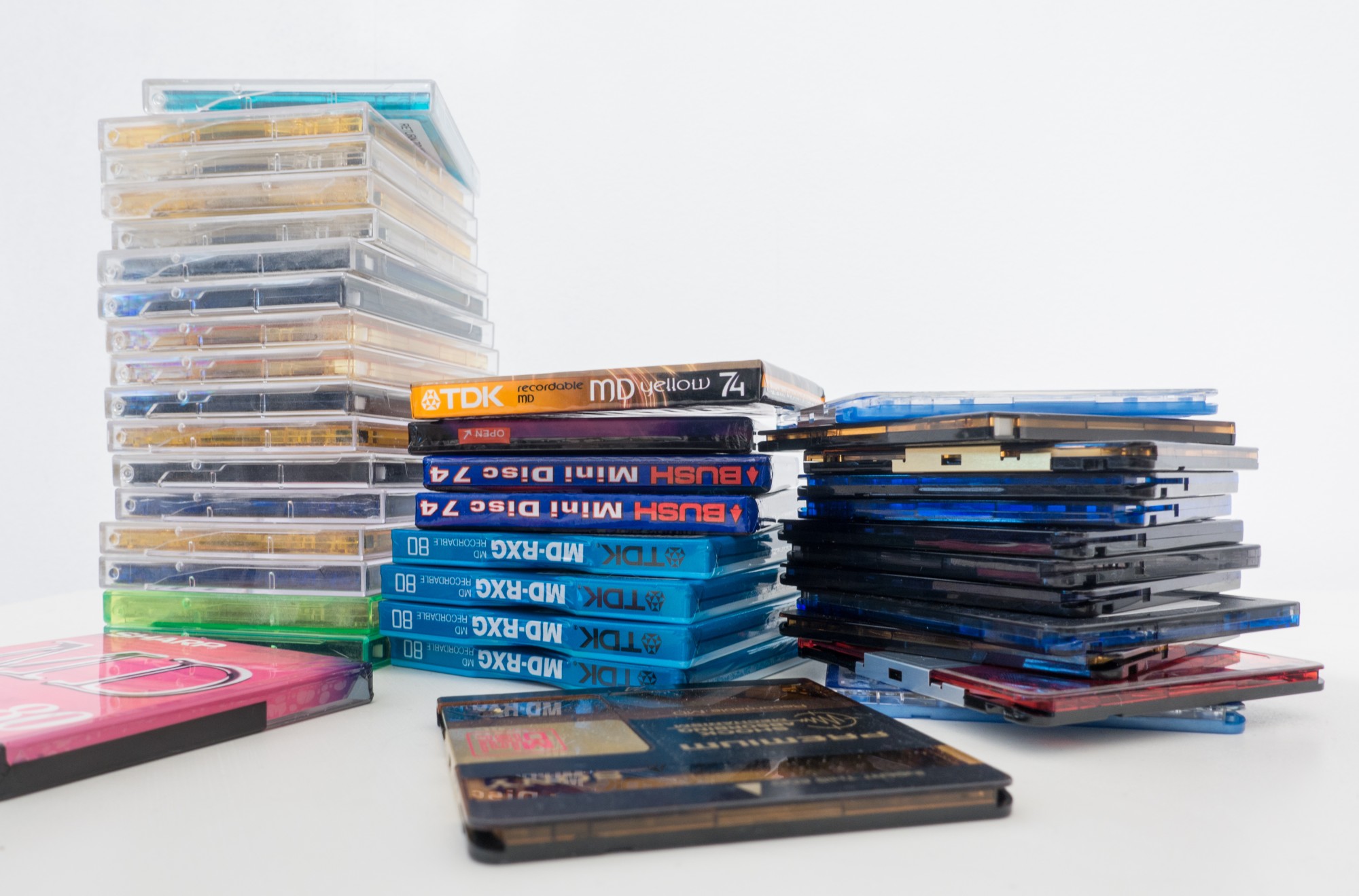
Well, in conclusion, let's try to do sofa analytics and imagine how it would be possible to do better? For example, so. The first minidisc player appears in 1992, it would not have been possible before. Already in 1993 computer drives are available with the ability to save up to 140 megabytes on each minidisk. Technology is widely licensed. Notebook manufacturers are willing to use mini-disk drives in models of 1994 and beyond - they can reduce the weight and cost of portable devices. The ATRAC format is available to device manufacturers and software developers for a small license fee. In 1997, users are able to compress music in ATRAC - for non-commercial use, codecs are available for free. In 1998, sales of CD-R drives did not grow - they remain niche devices, everyone is satisfied with the minidisk. The cost of the carrier drops to 50 cents.
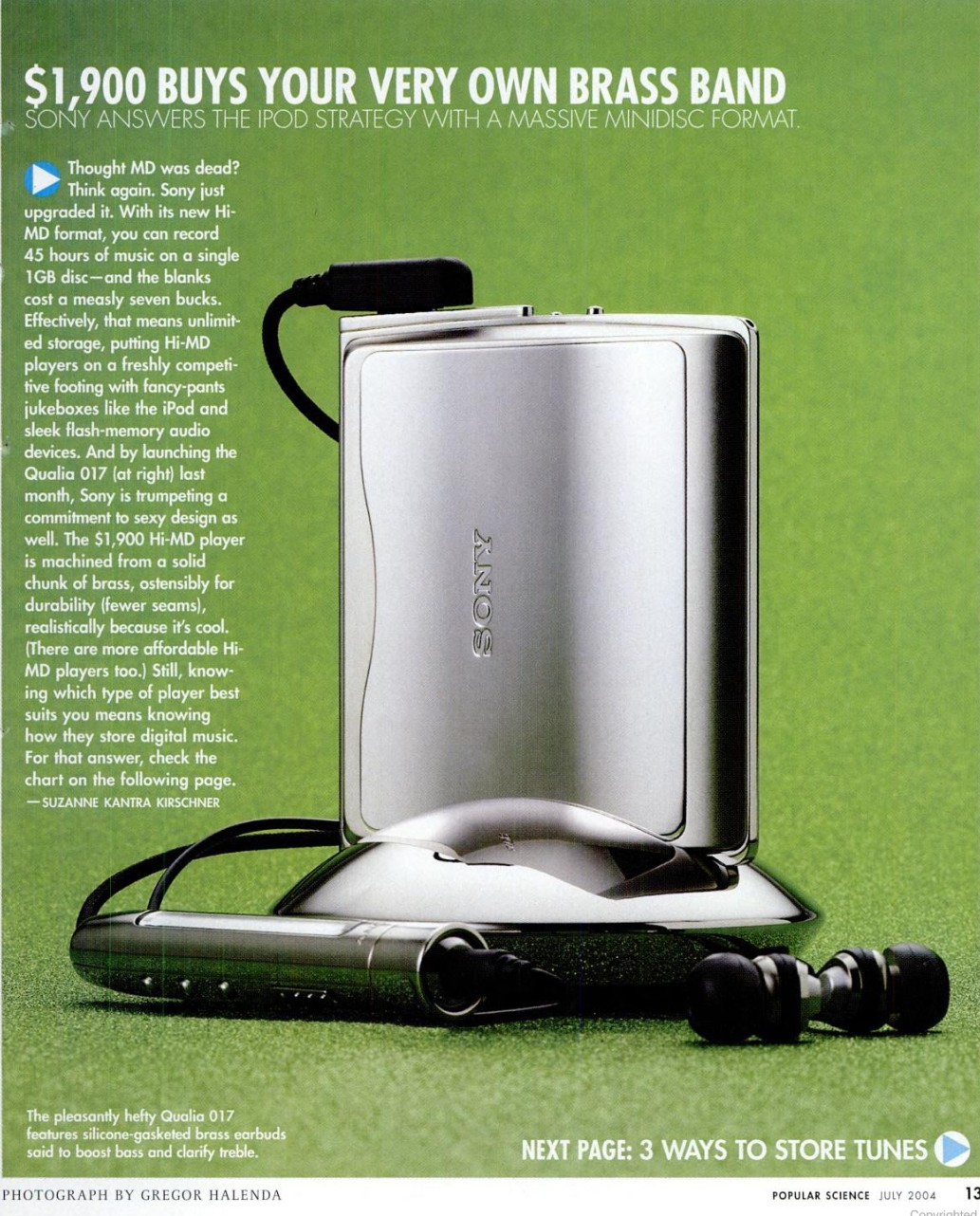
In 2004, the Hi-MD format was released, new drives are available in computers and laptops. In 2006, the capacity of the discs was brought up to 2 gigabytes, the format competes with DVD as a carrier for films. , , , . Submitted? , 2019 : . , , , . , .

, . , : , . — , . .
? , . — , . 30-40 , . , , — MP3-. . - .

Today I will talk about the minidisc in the era of MP3-players. Physical media with all its limitations, by definition, was not able to compete with portable devices based on hard disk or flash memory. Moreover, already at the beginning of the two thousand, the “music player” became part of other digital devices, and as soon as they became more or less convenient, not a single physical carrier had a chance. However, thanks to Sony’s perseverance, the history of the MD does continue until 2006 — when the latest new device was introduced. Sony three times tried to update the format for new consumer requests, and lost three times, and probably the idea was initially doomed to failure. But now, five years after the final cessation of support for the format, I have the opportunity to try out a few old devices, and tell them about them.
I keep the diary of the collector of old pieces of iron in real time in the Telegram . About some features of mini-disk devices there are written in much more detail.
')
First I want to resolve the misunderstanding that arose in the comments to the previous article. Minidisk and Mini CD are different formats. The Mini CD is a smaller copy of a regular 8 cm diameter CD (24 minutes of audio or 210 megabytes of data). Despite attempts to make it a portable format, devices using compact CDs (or DVDs, such were also) can be counted on fingers. The minidisk has a smaller diameter (64 mm), is equipped with a metal insert in the center and is closed in a protective case that is similar in construction to a floppy disk.

In the previous article I stopped at the end of the nineties, when the first MP3 players appeared. These were not the most convenient devices, but their advantages were obvious: there is no need to buy music carriers at all, rewrite a new collection of 64 or 128 megabytes of a portable device at least twice a day, without restrictions. A bit later, players with a built-in hard disk were added to them, and portable CD players experienced a brief renaissance thanks to the ability to play compressed music. The devices were rather clumsy, the first MP3 players used a parallel port for data transfer, and at the beginning of the two thousandths this was certainly the future, but it was not cheap and with dubious qualities.

But portable mini-disc recorders have reached perfection. In the 2000th year, the Sony MZ-R900 model is released, and after almost 19 years I buy such a player, and I am incredibly lucky: the device in a fashionable color blue metallic comes new (!), In a box with all the accessories. The player's dimensions have decreased even compared to the thin MZ-R55, and the battery life has increased - up to 26 hours of work from the built-in flat battery, and up to 66 hours with an additional case for one AA battery. Anti-shock increased to 40 seconds, and the larger the buffer, the less often you have to turn the disk, the lower the power consumption. The MZ-R900 is the best implementation of the format in its original form.

The main feature of the model is the support of the new standard MDLP. Here begins the confusion of terms, trademarks and names, which will pursue the minidisk to the very end. MDLP makes it possible to record on a minidisk in two or four times more information than was previously available. Prior to that, a minidisk contained a maximum of 80 minutes of music, or 160 minutes in mono mode. On the Sony MZ-R900, you can record 160 minutes of stereo sound or 320 minutes with reduced quality. The ATRAC3 codec is used for this, but wait, the last time I said that in the decks of the late nineties, was the ATRAC4.5 format already? Yes, but this is not the ATRAC . The first one, with all its modifications, was renamed ATRAC SP, and ATRAC3 is a completely new format. Where did ATRAC2 go then? Unknown. Third-party manufacturers had their own numbering of the original ATRAC codec, for example, Sharp had versions 5 and 6.

In 2001, even Sony itself advertised completely different products.
In short, the new LP2 and LP4 recording modes first appeared in the new Sony player. The first has a 132 kilobit bitrate per second, the second is 66 kilobits. LP4 is of little use for music, but it allows you to record more than five hours of voice notes per minidisk, with acceptable quality. LP2 according to characteristics approximately corresponds to MP3 with a bit rate of 128 kilobits per second. Sony is even conducting a study in which LP2 shows a slight advantage over MP3, although ATRAC3 ranks last in this independent test.
Regardless of the quality, the ability to record 2 hours and 20 minutes of music on a standard minidisk is useful; most of the double albums and compilations will fit in such timing. At the end of December, I go on a New Year's trip, and take a 2-hour Depeche Mode concert with me on the mini-disc. MDLP was the latest version of the MD, which produced the entire range of audio devices: home, portable and car. The Sony MZ-R900 looks gorgeous even at the modern look, it is very convenient to use it thanks to the wired console, large screen and two jog dial joysticks on the case, it sounds great and shows a good result in objective measurements. Whether to change the playback time to sound quality - the choice is yours.
Minidisk with USB port: suffering and pain
80 minutes or 160 - you still have to rewrite them on the MD in real time. Meanwhile, in 2001, Apple released the very first iPod MP3 player, still with a mechanical scroll wheel, with a monochrome screen and a 5 GB hard drive. By modern standards, a little, but then the player advertises the ability to carry with them all the music in general. 5 GB with a bit rate of 128 kilobits per second is about 86 hours of sound or 32 minidisks. Doofig. First, sales of iPod are small, the device works only with Apple computers, and only through the Firewire port, but over time these shortcomings will eliminate, and on the whole, Apple’s current success largely resulted from good sales of iPods in the two thousandths.

And Sony at the end of 2001 represents the NetMD format - this is essentially a mini-disk recorder with a USB port. In theory, this is an interesting proposal. You can transfer music from a computer to MDs 16 times faster than real time (for LP2 format). Recorders are expensive, well, and the iPod is not cheap, but you can decide for yourself how many MDs you need. The first NetMD recorder - Sony MZ-N1 - a very beautiful model with a docking station, up to 110 hours of battery life. I’m buying another device in the collection - the Sharp IM-DR410H recorder . This is a relatively inexpensive (210 euro at the start of sales) model of 2003. It works from one finger-type battery, it does not have a remote control, but it has convenient buttons and a digital sound amplifier, which promises an incredible high.

And this exhibit of my collection, everything goes wrong. The device looks almost perfect, but as it turned out after the first start, only one MD can lose, which was attached by the seller. The reason for this was, apparently, a fall to the floor, because of which the appearance did not suffer, but a fastener connecting the halves of the mechanism inside was riveted. I conjured a screwdriver, laid a piece of paper with a frame that presses the minidisk on top (it bent on impact), and brought the device into working condition.

Next, it was necessary to connect the player to the computer, and this was also a problem. On the Sharp site, the advertising page of the beginning of the two thousandth is still available, but nowhere can I download the bundled software and drivers, and I did not have a disk. Sharp devices used the BeatJam program, and Sony used a different software for its recorders — SonicStage, which Sharp doesn’t see. I never found BeatJam - the minidisc community forum would help, but just a month before my experiments started, it was turned off. ( Amendment: at the time of this writing, it was turned back on, hurray! ).

I had to use moderate mad skillz - I registered the Sharp's USB ID in the driver for Sony's mini-disk recorders, and after that it worked. Sony SonicStage (the latest version that supports MiniDiscs -

SonicStage interface is similar to that of Apple iTunes. By today's standards, the program is quite limited, and does not understand many music formats. I used it mostly with MP3 and WAV files. There is a possibility of organizing a library of files, writing tags, creating playlists. You can live, questions begin when copying music to the minidisk. First, you can only record music on the minidisk, you can not back. Secondly, in earlier versions of the software there was a limitation - one track could be recorded on the mini disc no more than three times, after that it was necessary to carry out the so-called check-in - in fact, remove the track from one of the disks by connecting it to the computer.

But this is not the biggest problem. I added an album to the SonicStage collection, and he signed up for a minidisk at about tenfold speed - not bad. But this is the LP2 format with a bit rate of 132 kilobits per second. If your collection of music is in MP3 (and there were hardly any other options at the beginning of the two thousandth), then there is a double lossy conversion of music — first to MP3, then to ATRAC3 LP2. Is it possible to use the original ATRAC SP codec with a bit rate of 292 kilobits per second? It is possible, but here I was waiting for the two largest pitfalls. First, recording in ATRAC SP mode is very slow, at a speed of about 1.6x from the real one. As far as I know, this is because coding to the original ATRAC is possible only on the device . A software encoder does not exist until now , there is only a later developed and included in the ffmpeg package decoder (the fruit of reverse engineering fans).

Regardless of the quality of the source, before you transfer data to the MD, it is forced to encode to ATRAC3 LP2 format. Seriously, I even checked it myself, comparing the measurements of the MD recorded on the deck, in the old-fashioned way, and the minidisk recorded on the computer. The second option shows a noticeable increase in distortion - a clear sign of additional losses during compression.

Rate the degree of idiocy. Suppose you have music in good quality, for example, in MP3 320 kb / c. You want to record it on the minidisk in ATRAC SP format so that your old mini-disk deck (like mine) can play it too. SonicStage converts your MP3 to ATRAC3 LP2 (second lossy compression), then decompresses the sound to PCM, transfers it to the player, where it is converted to ATRAC SP (third compression!) By the device. How so? Why was this giant crutch inserted? Copyright? So it was easier to code? Imagine yourself in the place of a longtime minidisc fan, with an archive of records and old devices that expects NetMD to complement its infrastructure. But it does not complement. You either have to switch to an ATRAC3 LP2 that is incompatible with technology before 2000, or (perhaps you will not hear, but) you will know that you are writing compatible discs from a computer with completely unnecessary loss of quality.

Judging by the reviews of contemporaries, the impression they had was exactly this: Sony rotates fans of the format on the copyright spit. In order not to get up two times, add: the discs recorded on the computer cannot be edited on the player or recorder. No way, just format. They are marked as protected. For some reason, this mark is not put in the additional utility MD Simple Burner - this is a program for copying music to a minidisk directly from a CD. I use it with an optical drive emulator, and in general it works well. Even if you score on all these subtleties, the preferred way to work with a portable device at the beginning of the two thousandth is to write a dummy or transfer files to a portable player in the form in which they are stored on the hard disk. And that's not all.
To the frustration of NetMD added ambiguous impressions of the Sharp device. This Japanese company tried to differentiate their Minidisk players from Sony devices in design, features and sound. At the beginning of the two thousandth, she applied the technology of "digital one-bit sound" - in fact, she implemented a digital headphone amplifier in portable technology, which in theory is no different from that in modern smartphones. But this is in theory, but in practice Sharp decided to introduce a balanced power amplifier. The Sharp player has a four-pin connector, each channel is connected separately, while in ordinary headphones the left and right channels have a common ground. Included is an adapter from this connector to a conventional three-prong, but it is intended only for connecting a device in the line input - for example, to a car stereo. Headphones through the adapter sound awful because of the high output resistance.

What kind of headphones with a player put - so with them and go. There are simple “droplets” there, not bad, but modern headphones are much better, and I even solder my Sennheiser ie8 to work in balanced mode. It was difficult to measure the characteristics of the player in the RMAA program: all parameters were as expected, except for channel separation. The test showed that the separation was almost absent, as if the player was working in mono mode. Another measurement of a similar model ( here ) showed similar results. After a couple of experiments, I realized that the parameters of this player can be measured correctly only under load - I had to solder the headphones to the connecting cable, and only then did I get the characteristics I expected.

The promise of “Excellent Sound” was confirmed in the measurements: judging only by numbers, this is the best player in my collection. In fact, his sound is muddy, dull and generally markedly different from any other technique at my disposal. It is not ok. And in the recording mode, the modified ATRAC encoder adds some gag to the signal. Nevertheless, this Sharp is the ancestor of modern audiophile portable players with a balanced headphone amplifier.
The NetMD format was supported by fewer Japanese manufacturers. I don’t have any sales information, but I don’t think that Sony managed to catch up with the miniDisc iPod and manufacturers of rapidly decreasing MP3 players, a lot of handheld computers and smartphones with music features. The story should definitely be finished, but there was another attempt.
Hi-MD: engineering masterpiece, which was not needed

In January 2004, Sony announces (as the media says - returns from non-existence) a new format of minidisks - Hi-MD, with a capacity of 1 gigabyte, seven times the size of regular MD, while maintaining the dimensions. The principle of writing and reading data is still magneto-optical. The magnetic head is used for recording, and the disk is preheated by the laser to high temperatures. Only laser is used for reading. The recording density was increased with the help of several technologies at once. Magnetic writing to a high-density disk is possible in principle, but upon reaching a certain limit, it becomes impossible to read the data. This task was solved using the Domain Wall Displacement Detection method — another layer was added to Hi-MD discs aimed solely at improving the accuracy of reading. In addition, software methods were used: the EFM data coding method (also used in compact discs and providing the ability to recover data from damaged areas) was replaced with a more efficient RLL . PRML technology was introduced, also increasing the likelihood of successful data reading. She, like RLL, was borrowed from hard drives.
Furthermore, Hi-MD devices provide enhanced backward compatibility. Not only can they read data from traditional minidisks, but they can also reformat them with a doubling of capacity — about 80 megabytes of data can be written to an 80-minute standard MD. And here we are talking about data, and not just about sound: for the first time, the minidisk becomes a relatively convenient format for storing files. Any Hi-MD recorder can be connected to a computer via USB and without any software can be used as a USB flash drive.

Only very slowly, and by modern standards, and by the old - approximately at the level of a two-speed CD-ROM. These are indicators of conventional MD formatted according to the Hi-MD standard. Real gigabyte Hi-MD disks should work twice as fast, but I can’t check it - there are no disks. In general, I was going to study this part of the history of minidisks "based on materials on the Internet" - the prices of equipment and carriers are completely irresponsible. Sealed Hi-MD discs are sold for 30-50 dollars apiece, several times more expensive than their original value of seven dollars. The players are also not cheap, but I’m lucky and I’m cheaply buying the Sony MZ-NH600 in almost perfect condition.

This is a budget (200 dollars) model of 2004: it works from a finger battery for up to 27 hours in playback mode, and when connected to a computer it receives power via USB. The case is plastic, the buttons are not so convenient compared to the reference MZ-R900, for some reason many functions are hung on the microscopic wheel, and everything else is put on an even more miniature five-way joystick. In the USA, this model is not even equipped with a line input, recording only through a computer. In general, a very convenient and compact model, though not as cool as the flagships (about them later). The only problem - a very quiet headphone output - a consequence of EU legislation on limiting the maximum volume. But I solve this problem with the help of the service menu (more about this in my Telegram ).

If you want to record music to Hi-MD, you still need to use the SonicStage program. Together with the new disc format, a new standard (another one) for lossy data compression, ATRAC3Plus, was developed. It offers a wide range of bit rates, as well as MP3, the maximum - 256 kilobits per second (later it will be expanded to 352 kilobits). There is an opportunity to record uncompressed audio on a minidisk with a full CD quality - one and a half hours on a Hi-MD disc and 28 minutes on a standard but reformatted minidisk. In 2004, it was this opportunity that interested me, but instead of a minidisk, I buy my first 40 GB iPod.

Table of formats supported on Hi-MD devices from minidisc.org
What is the result? With a bit rate of 256 kilobits per second, you can record almost 8 hours of audio per gigabyte Hi-MD disc. If you use the more economical ATRAC3 LP2 codec, you’ll generally get 16.5 hours. A couple of discs can carry a lot of music with them, and even on old mini discs you can record almost five hours of audio in decent quality. True, you can read all this only on Hi-MD devices - all previous devices will not see the new format. Finally, you can copy music not only to the minidisk, but also back! The truth is with limitations: only from Hi-MD discs, those who want to extract music from their old minidisks are again in the span. Sony is gradually releasing the copyright reins, and eventually it becomes possible to extract music from the original MD, but only if they are recorded via an analog input. But there is a big life hack, more precisely a hardware cheat code.
Sony MZ-RH1: The Holy Grail

In 2006, Sony released the latest (now for sure) Sony MZ-RH1 minidisk player. Usually, at sunset format only the cheapest and most dull in design and device characteristics remain on sale. But RH1 is not like that; it’s the real top, the top of the format capabilities. The thickness of the player is 15 millimeters, almost three times less than that of the very first minidisc device MZ-1. Weight 106 grams with battery, 6.5 times less. Incredibly cool OLED-display, lithium-ion battery with the ability to charge via USB.

I don’t have such a player, the prices for it are completely equine - much higher than it cost the new one in 2006. In addition to technical excellence and collection value, there is another reason for such a high price. This is the only MD player capable of transferring data from standard MD without restrictions . If you have a large collection of your own music or other audio recordings on minidisks, and you used a digital interface for recording, then you can get these records relatively painlessly only with the help of RH1. Or it is necessary to use more complex methods: I successfully extracted digital sound from the MD, replacing the table of contents using the TOC Cloning method described in the previous article. The MZ-RH1 has no practical meaning: as with any top-end player, it has its drawbacks, for example, a proprietary and incompatible battery and a burnable OLED display. My MZ-NH600 is more practical.
Open source
In the middle of the two thousandth, work begins on the reverse engineering of the NetMD and Hi-MD protocols. Information about the linux-minidisc project can be obtained here , and here are the sources . The mailing list of the project participants makes it clear how difficult it was for them to analyze the most closed minidisc architecture. But after all, for the iPod, which was also closed on all sides, third-party file managers came up with it, and even wrote a whole alternative firmware. Perhaps, if the devices were a bit more popular, it would have happened with Sony NetMD and Hi-MD. In fact, the project is not dead, but the development has stopped halfway.

Since Hi-MD uses the usual FAT file system, it is best supported in Linux, there is even a simple graphical interface for transferring files back and forth. But the support of traditional minidisks (no matter what device) leaves much to be desired. In fact, you are dealing with a set of utilities (or Python scripts, at your choice) for copying music to a minidisk (for all NetMD devices) and back (if you have MZ-RH1). It was not possible to break the NetMD protection to the end, and perhaps this requires the extraction and modification of the firmware of the devices. It is unlikely that someone will do it now - what's the point of disassembling outdated hardware? Console utilities are the only way to download music to the minidisk in the original ATRAC SP format without unnecessary transcoding to LP2. Alas, the utilities are unstable - the device constantly freezes, you have to reconnect it and start again.
Failure or failure?
After the release of the MZ-RH1 player in 2006, there was nothing to hear about the MDs, until in 2013 Sony announced it would stop supporting the format. Was minidisk a failed product? It seems to be yes: all my life sales were relatively small, devices and carriers were expensive, and recent attempts to adapt the format to the requirements of the network century failed. And why did this happen? Someone will say - the format was too closed. And it will be right, see above examples about stupid limitations when working with a mini-disk on a computer. But the iPod was also like that. There, too, it is impossible to get music from the player back to the computer using standard means. The same codec set is also used (but MP3 is supported). In 2004, along with Hi-MD, Sony opened its online music store, a year after the iTunes Store. Both there and there the tracks are smeared with a thick layer of copy protection: only in 2009 the Apple store will completely abandon DRM.
Okay, then probably this format appeared too late: if we released it along with a compact disc in 1982, we would now recall with nostalgia MDs, not tapes. It would be nice, but the principle of magneto-optical recording was only publicly demonstrated in 1983. And even in the MD-player of 1996, there is such a jumble of boards and mechanics that it becomes clear that the technical capabilities, even in the mid-nineties, made it difficult to make digital equipment so compact.
My version: just not destiny. Sony, with reservations, did everything right, released a new format to the market as early as possible and for many years finished it to the ideal. It was impossible to imagine at the beginning of development what revolution in digital music the Internet would produce. This is an example of technology, in which a lot of strength and talent has been invested, everyone tried very hard and they were great, but in the end nothing came of it. It happens.

Well, in conclusion, let's try to do sofa analytics and imagine how it would be possible to do better? For example, so. The first minidisc player appears in 1992, it would not have been possible before. Already in 1993 computer drives are available with the ability to save up to 140 megabytes on each minidisk. Technology is widely licensed. Notebook manufacturers are willing to use mini-disk drives in models of 1994 and beyond - they can reduce the weight and cost of portable devices. The ATRAC format is available to device manufacturers and software developers for a small license fee. In 1997, users are able to compress music in ATRAC - for non-commercial use, codecs are available for free. In 1998, sales of CD-R drives did not grow - they remain niche devices, everyone is satisfied with the minidisk. The cost of the carrier drops to 50 cents.

In 2004, the Hi-MD format was released, new drives are available in computers and laptops. In 2006, the capacity of the discs was brought up to 2 gigabytes, the format competes with DVD as a carrier for films. , , , . Submitted? , 2019 : . , , , . , .

, . , : , . — , . .
? , . — , . 30-40 , . , , — MP3-. . - .
Source: https://habr.com/ru/post/435358/
All Articles